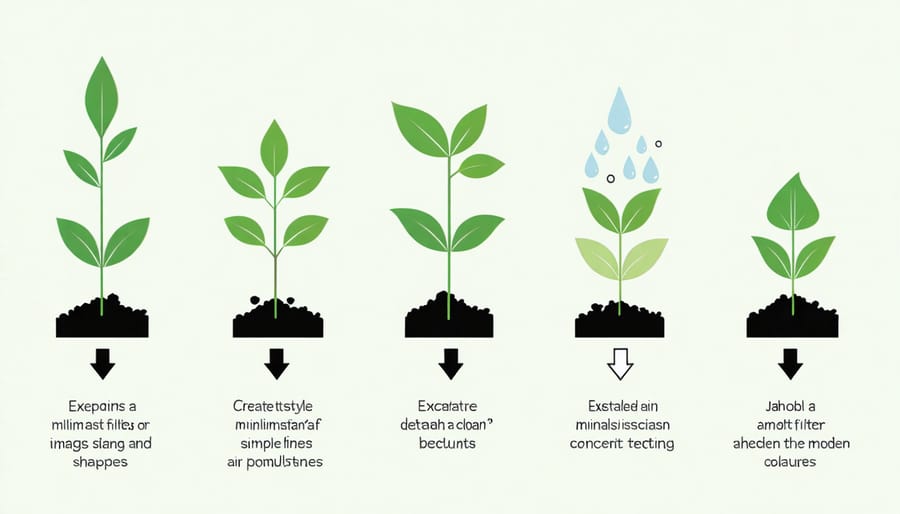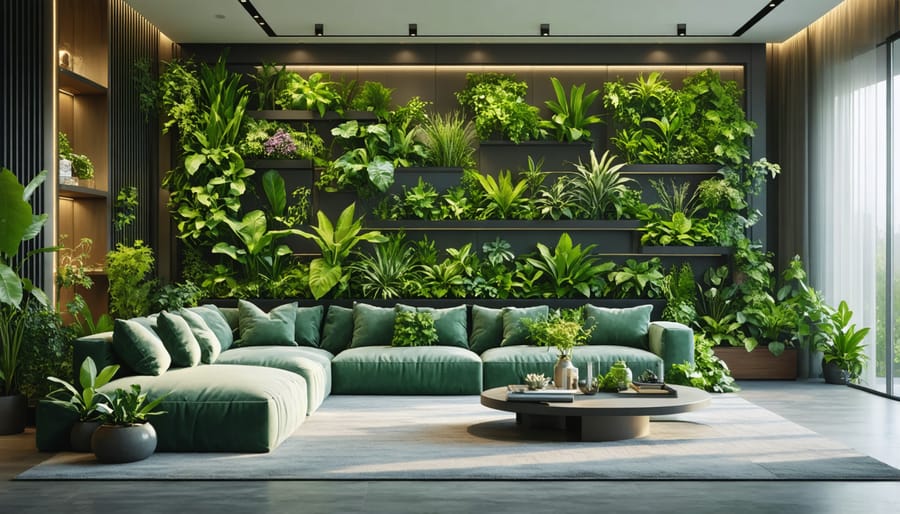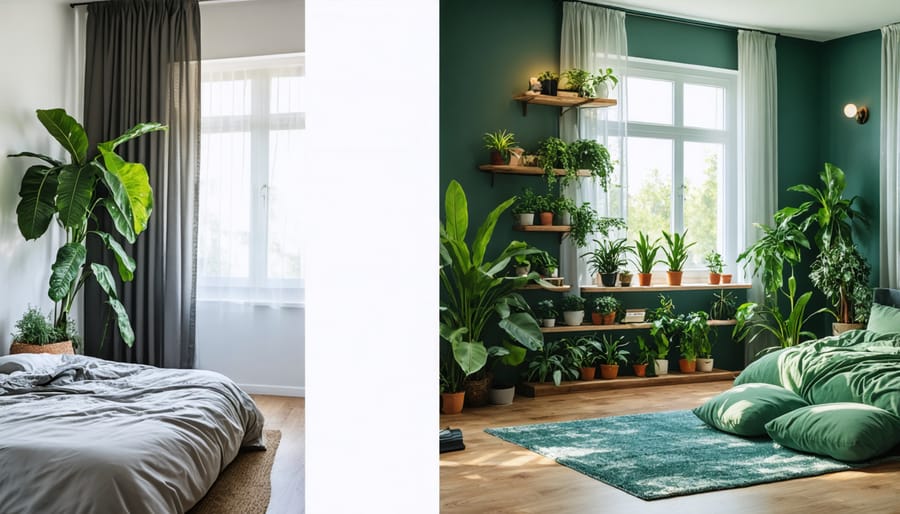Transform your living space into a thriving ecosystem by embracing biophilic design principles – the revolutionary approach that seamlessly connects human spaces with nature. This design philosophy isn’t just about adding a few houseplants; it’s a scientifically-backed strategy that can reduce stress, improve air quality, and enhance overall wellbeing by up to 15%, according to recent studies. From living walls that purify indoor air to carefully positioned windows that maximize natural light, biophilic design transforms ordinary rooms into rejuvenating sanctuaries that satisfy our innate need to connect with nature.
Modern urbanites spend over 90% of their time indoors, making it crucial to incorporate elements that bridge the gap between built environments and natural systems. Whether you’re renovating your entire home or simply refreshing a single room, implementing biophilic design elements can create spaces that not only look stunning but also promote physical and mental wellness. The beauty of this approach lies in its versatility – it can be adapted to any budget, space size, or architectural style while delivering measurable benefits to your living environment.
The Science Behind Biophilic Design and Air Quality
How Plants Purify Indoor Air
Plants do more than just beautify your space – they’re natural air purifiers working around the clock to keep your indoor environment healthy. Through photosynthesis, plants absorb carbon dioxide and release oxygen, but their air-cleaning abilities go far beyond this basic exchange.
The magic happens through a process called phytoremediation, where plants filter harmful volatile organic compounds (VOCs) through their leaves and roots. These toxins, which can come from everyday items like furniture, paint, and cleaning products, are broken down by plants into harmless substances they can use for their own growth.
Different plants excel at removing specific pollutants. For example, peace lilies are champions at removing benzene and trichloroethylene, while spider plants tackle carbon monoxide and xylene with impressive efficiency. Snake plants work overtime by converting CO2 to oxygen even at night, making them perfect bedroom companions.
The soil and root system of plants also play a crucial role, hosting beneficial microorganisms that help break down air pollutants. For optimal air purification, consider placing one medium-sized plant per 100 square feet of indoor space.

Natural Ventilation Principles
Natural ventilation is a cornerstone of biophilic design, bringing the outside air in while creating a healthier indoor environment. By strategically placing windows, doors, and other openings, you can create natural airflow patterns that mimic outdoor breezes, reducing the need for artificial ventilation systems.
The key to effective natural ventilation lies in understanding your space’s natural air currents. Cross-ventilation, achieved by placing windows on opposite walls, allows fresh air to flow freely through your home. Stack ventilation, which uses temperature differences to move air vertically through your space, can be enhanced by incorporating features like clerestory windows or skylights.
Plants play a crucial role in this system, acting as natural air purifiers while adding visual appeal. Consider placing larger plants near ventilation sources to help filter incoming air. Temperature regulation becomes more efficient when you combine proper window placement with thoughtful landscaping, such as deciduous trees that provide shade in summer but allow warmth in winter.
To maximize these benefits, keep windows clean and unobstructed, and ensure that air pathways remain clear. This approach not only improves air quality but also creates a more comfortable, nature-connected living space.
Essential Elements of Air-Purifying Biophilic Design
Best Air-Purifying Plants for Your Space
When it comes to purifying your indoor air naturally, certain plants are particularly effective at removing common pollutants while adding beauty to your space. While styling indoor plants effectively is important for aesthetics, choosing the right varieties for air purification can make a significant difference in your indoor air quality.
The Snake Plant (Sansevieria) is a top performer, known for filtering out formaldehyde and requiring minimal maintenance. Place these architectural beauties in bedrooms, as they continue to produce oxygen even at night. Spider Plants are another excellent choice, particularly effective at removing xylene and carbon monoxide. They’re perfect for hanging baskets in living areas or home offices.
For larger spaces, the Peace Lily is a stunning option that tackles benzene and trichloroethylene while adding a touch of elegance. Just keep it away from pets, as it can be toxic if ingested. The hardy Pothos is perfect for beginners and excels at removing indoor air pollutants while thriving in various light conditions.
To maximize air-purifying benefits, aim to have one medium-sized plant per 100 square feet of indoor space. Position your plants where air circulation is good, such as near windows or in frequently used rooms. Remember to dust leaves regularly and maintain proper watering schedules to keep your green air purifiers working effectively.
Natural Materials and Air Quality
Creating a healthier indoor environment starts with choosing the right natural materials. Wood, bamboo, and cork not only add warmth and texture to your space but also help regulate humidity levels naturally. These materials act as natural air filters, absorbing and releasing moisture as needed to maintain optimal indoor air quality.
Consider incorporating natural stone elements like slate or granite, which don’t emit harmful VOCs (volatile organic compounds) commonly found in synthetic materials. Pure wool carpets and natural fiber textiles act as natural air purifiers, trapping dust and allergens while adding comfort to your space.
Plants are your greatest allies in promoting cleaner air. Spider plants, peace lilies, and snake plants are particularly effective at removing common indoor pollutants. Pair these with natural clay or lime-based plasters on your walls, which help regulate humidity and filter air pollutants.
When selecting finishes and paints, opt for those made from natural ingredients like milk paint or mineral-based options. These choices release fewer toxins compared to conventional alternatives. Natural beeswax candles can also contribute to better air quality by releasing negative ions that help clean the air of dust and pollutants.
Remember to maintain good ventilation by incorporating natural airflow patterns in your design. Position windows and doors to create cross-ventilation, allowing fresh air to circulate while naturally filtering out pollutants through your chosen materials.
Living Walls and Vertical Gardens
Living walls and vertical gardens are transforming indoor spaces into vibrant, air-purifying sanctuaries. These stunning green installations do more than just catch the eye – they actively improve your indoor air quality while bringing nature’s beauty right into your home. Whether you’re working with a spacious living room or a cozy apartment, there are living wall designs to suit every space and style.
These botanical walls act as natural air filters, removing common indoor pollutants like formaldehyde, benzene, and volatile organic compounds (VOCs). Plants like spider plants, peace lilies, and pothos are particularly effective at purifying air, making them excellent choices for your vertical garden.
Creating your own living wall doesn’t have to be complicated. Start with a modular system that allows for easy plant maintenance and replacement. Consider factors like light exposure, irrigation needs, and plant selection based on your space. Low-maintenance options like ferns, philodendrons, and succulents are perfect for beginners.
The benefits extend beyond air purification. Living walls help regulate humidity levels, reduce ambient temperature, and absorb noise. They’re also known to boost mood and productivity while decreasing stress levels – making them perfect for both home and office environments.
Remember to establish a regular maintenance routine, including proper watering, pruning, and monitoring plant health. With the right care, your living wall will thrive and continue purifying your air for years to come.

Practical Implementation Tips
Room-by-Room Design Strategies
Each room in your home presents unique opportunities to incorporate biophilic elements. In the living room, position larger plants near windows and use natural materials like wooden furniture and stone accents to create a cozy atmosphere. Consider adding a small indoor water feature to introduce gentle, natural sounds.
For bedrooms, focus on calming elements like botanical wallpapers or murals, and choose plants known for their air-purifying qualities such as snake plants or peace lilies. Place them away from the bed to maintain good airflow while sleeping.
Kitchens benefit from herb gardens that combine functionality with biophilic design. Install a vertical garden wall for fresh herbs, or arrange potted plants on windowsills. Use natural stone countertops and wooden cutting boards to reinforce the connection with nature.
In bathrooms, opt for moisture-loving plants like ferns and bamboo. Install windows or skylights where possible to maximize natural light. Consider using natural tiles with organic patterns and adding wooden bath mats or storage solutions.
Home offices should incorporate views of nature when possible. Position your desk near a window and add climbing plants or hanging baskets. Use natural materials for desk accessories and consider a living wall as a backdrop for video calls.

Maintenance and Care Guidelines
Maintaining your biophilic elements isn’t just about keeping them looking beautiful – it’s essential for maximizing their air-purifying benefits. Start by establishing a regular cleaning routine for your living walls and potted plants. Gently dust plant leaves weekly using a soft, damp cloth to keep them breathing effectively and looking vibrant.
For living walls, inspect the irrigation system monthly to ensure proper water distribution and prevent mold growth. Monitor soil moisture levels in all planted areas – neither too wet nor too dry is the key. A moisture meter can be a helpful tool for beginners.
Natural ventilation elements require periodic attention too. Clean window screens seasonally and ensure ventilation paths remain unobstructed. For water features, change the water regularly and clean filters monthly to prevent algae buildup and maintain healthy air circulation.
Indoor plants need proper fertilization every 3-4 months during growing season. Choose organic fertilizers to maintain optimal air quality. Remove dead or yellowing leaves promptly, as they can harbor mold and affect air purity.
Remember to rotate potted plants quarterly so they grow evenly, and trim overgrown sections to maintain healthy airflow. During winter months, maintain consistent humidity levels using natural methods like pebble trays filled with water rather than artificial humidifiers.
For larger biophilic installations, consider scheduling professional maintenance twice yearly to ensure all systems function optimally for the best air-purifying results.
Budget-Friendly Implementation Ideas
Bringing biophilic design into your space doesn’t have to break the bank. Start with low-maintenance indoor plants like pothos, snake plants, or ZZ plants, which are both affordable and excellent air purifiers. Place them strategically near windows or in corners where they can thrive with minimal care.
Natural light is free! Maximize it by removing heavy curtains and replacing them with sheer fabrics. Position mirrors opposite windows to bounce light deeper into your space. Consider rearranging furniture to create clear pathways for natural light flow.
Create nature-inspired focal points using found objects like driftwood, pinecones, or interesting rocks as decorative elements. Display them in glass jars or arrange them on shelves for instant natural charm. You can also press leaves or flowers to create free botanical artwork.
Transform your view with window boxes filled with herbs or small plants. Not only do they bring nature closer, but they’re also practical for cooking. Use natural materials like jute, bamboo, or reclaimed wood for storage solutions and decorative elements.
Paint is an affordable way to bring in nature-inspired colors. Choose earthy tones or soft greens to create a calming atmosphere. Add natural textures through affordable jute rugs, wooden picture frames, or cotton throws with organic patterns.
Remember, biophilic design is about connecting with nature, not perfection. Start small, adding elements gradually as your budget allows, and watch your space transform into a more natural, peaceful environment.
As we’ve explored throughout this article, biophilic design offers a powerful, natural approach to improving indoor air quality while creating spaces that nurture our wellbeing. The benefits are clear: reduced stress levels, increased productivity, better air filtration, and spaces that feel more alive and connected to nature. By incorporating elements like living walls, indoor plants, natural materials, and proper ventilation systems, you’re not just designing a beautiful space – you’re creating a healthier environment for yourself and your loved ones.
The beauty of biophilic design lies in its flexibility. Whether you’re working with a spacious home or a compact apartment, there’s always room to introduce natural elements. Start small with a few strategically placed plants, or go bold with a living wall installation. The key is to begin somewhere and gradually build upon your initial efforts.
Remember, improving air quality through biophilic design isn’t just about aesthetics – it’s an investment in your health and wellbeing. The plants you introduce act as natural air purifiers, removing common indoor pollutants while adding moisture to the air. Natural materials like wood and stone help regulate humidity levels and create a more balanced indoor environment.
Ready to take the first step? Begin by assessing your space and identifying areas where you can introduce natural elements. Consider starting with low-maintenance plants like snake plants or pothos in areas where you spend the most time. Pay attention to natural light sources and ventilation patterns in your home to maximize the effectiveness of your biophilic elements.
The journey to better indoor air quality through biophilic design is ongoing, but the rewards are immediate and long-lasting. As you implement these natural solutions, you’ll likely notice not just improved air quality, but also a greater sense of connection to nature and overall wellbeing. Your space will become more than just a place to live – it will be a sanctuary that supports your health and happiness naturally.
